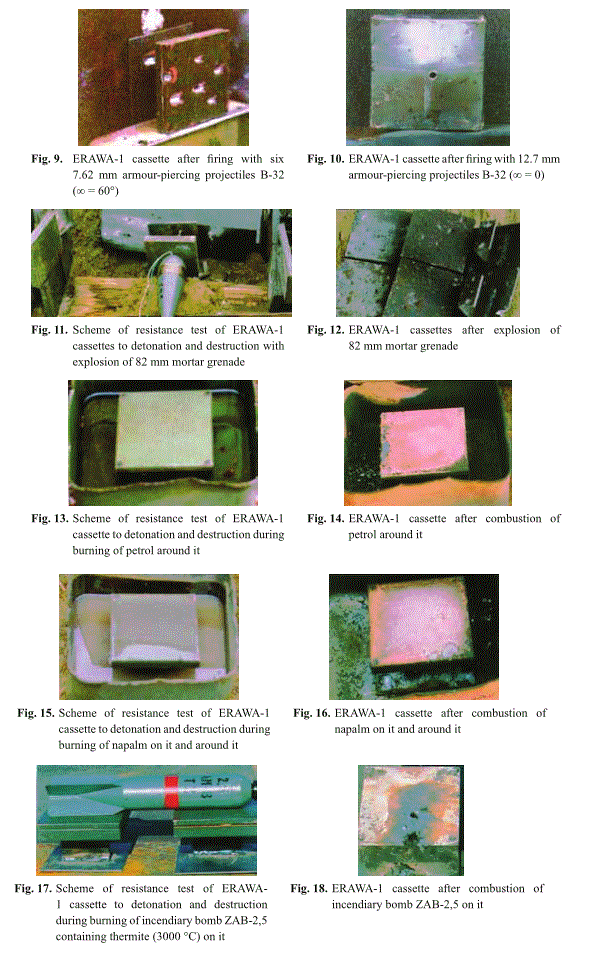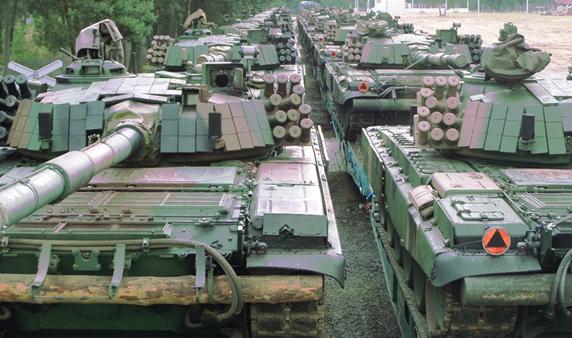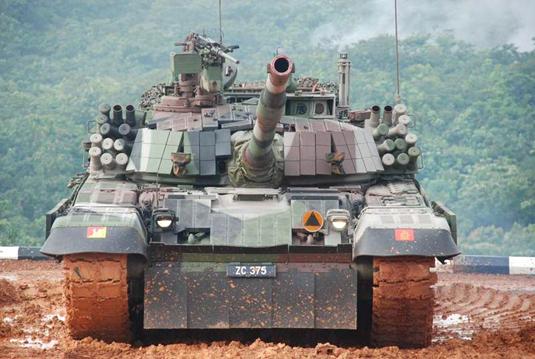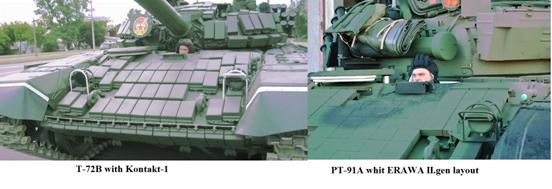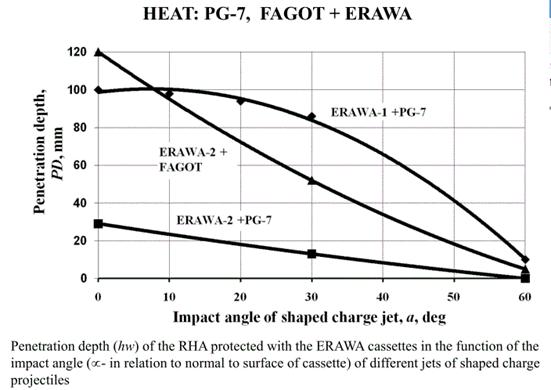|
|||||||||
|
|
Polish Explosive reactive armor:
ERAWA-1 and ERAWA-2
·Origins of the ERAWA armor
·ERAWA -1 – the build and effectiveness
·ERAWA -2 – the build and effectiveness
·ERAWA armor on PT-91 and PT-91MZ
·ERAWA-2 unique features, and compare whit other ERA armors.
Origins of the ERAWA armor
The ERAWA armor is connected whit person of the Prof. Ph.D.
D.Sc. Adam WISNIEWSKI from Military Institute of Armament Technology (WITU)
in
The origins of the ERAWA are hidden in half of the 1980s when polish Military
Institute of Armament Technology had started (in
person Prof. Ph.D Wisniewski)
development process about new armor for deep modernization of the T-72M1. In
fact WITU work had started about whole family of the armor whit two „tank”
part: ceramic CAWA armor for main tank armor and
explosive ERAWA armor as external layer.
Rumors about eastern (
New armor ERAWA-1 was available in 1993 whit first PT-91 prototype.
ERAWA -1 – the build and efectivnes
(Photo description:
Left: ERAWA-1 TX cassette
Right: ERAWA-1 patent draw: 1-casette; 2-HE (trotyl or trotyl-heksogen); 3- external HHS (HB500) plate
~6mm thick; 5,6 – screws;
7 - brackets for ERAWA-1 cassette in distance 30-50mm form armor )
I. Parameters:
1. Size of the ERAWA-1 cassette -
150x150x26 mm
2. Mass of the ERAWA-1 cassette -
ERAWA-1 is build form RHA cassette whit HE
insert (TNT or TNT-hexogen) cover by circa 6mm HHS plate whit 500HB hardness.
Whole cassette is mounted by two screws to the
brackets. This build, seems to be primitive, but thanks to
strong explosive and very good quality HHS plates provides very good
capability of the protection:
Capability of the Protection is based on formula:
CP - capability of protection In result ERAWA-1 (single layered) have sucht efectivnes valued in CP factor:
against hand held AT weapons sucht Komar (The Mosqito), PG-7 and
PG-9 whit (circa 300-330mm RHA penetration):
CP = 92%
against 9M113 warhed (circa 460mm RHA
penetration):
CP = 83%
against 125mm BK-14M round (circa 450mm RHA penetration):
CP = 94%
ERAWA-1 casettes are insensitive to react:
·during
impact of
·AP
small calibre amunition
·fragments
from exploding projectiles
·during
burning of by: petrol, napalm, thermite
Seafty tests ERAWA-1 photos:
ERAWA -2 – the build and effectives
ERAWA-2 (two layered) was answer for modern thread: AT weapons whit
precursor (PG-7VR, MBT LAW, Panzerfaust-3T etc), EFP projectiles formed from
100mm cone diameter, partially APFSDS penetrators,
and challenge to reduce RCS tank signature. ERAWA-2 and ERAWA-1 cassettes are
fully swichable.
Basic parameters of the ERAWA-2 cassette:
Photo description:
Left: ERAWA-2 TX02 cassette
Right: ERAWA-2 patent draw: 1-casette; 2 double HE layer (trotyl or trotyl-heksogen); 3-
thin HHS plate separation two HE layers;
4- thin metal lid ; 5 – ceramics layer; 6 – thin HHS plate; 7-
rivet/screw; 8 - brackets for ERAWA-2 casette in distance 30-50mm form armor; 9 – screw between cassette and brackets, 10 –
mounted nut. )
Parameters:
1. Size of the ERAWA-2 cassette - 150x150x46 mm
2. Mass of the ERAWA-2 cassette -
Internal build of the ERAWA-2 cassette is much more sophisticated then
ERAWA-1 and it's very different then other known ERA cassettes.
Basic build is similar to the ERAWA-1 – metal cassette attached by mounted screws to brackets in distance 30-50mm
from armor surface. But internal ERAWA-2 build is different. First they are
two HE layers inside cassette separated by thin (circa 2-3mm) HHS plate whit
hardness above 500HB. Probably both HE layers have slightly different HE
material whit different reaction time and other parameters. Second – external
ERAWA-2 plate is not thick HHS plate but multilayered layout made by:
thin metal lid then circa 4-5mm thick ceramic layer and
second thin (circa 2-3mm) HHS plate whit hardness above 500HB.
Such, unusual, layout make ERAWA-2 different then other known ERA. And
give surprisingly good capabilities of the protection:
·Agiainst single SC (HEAT) warheads like 9M113 (Konkurs) or 9M111M (Fagot) or BK-14M
CP = 95%
·Against single EFP formed form 100mm cone diameter and
penetration circa 85mm RHA
CP= 94%
During test ERAWA-2 proof abiities to protect
in PT-91 hull top and turret top against EFP formed from 50-155mm cone
diameter (so up to 120mm RHA penetration) and to protect hull sides against
EFP formed form 200mm cone (so up to 150mm RHA penetration).
·Against APFSDS rounds 3BM15 (125mm) and DM-33A1 (120mm)
CP in first case (3BM15) was equal to 57%
CP in second case (DM33A1) was not given, but
ERAWA-2 placed on PT-91 hull model (so T-72M1) was enought to stop APFSDS whit guaranted 470mm RHA penetration, from 600m distance:
In this case DM-33 penetartor was heavy damage
during ERAWA-2 penetration, then perforate first plate and rebound from
deeper (glas textolite)
layers without reach second RHA plate (backplate)
PT-91 hull is consist by: (for 90 degree)
So
layout for 68 degree is: ~120mm ERAWA-2 cassette + 160mm RHA + 280mm STEF +
146mm RHA
Guaranteed
DM-33A1 penetration is 470mm RHA on 2000m. DM-33A1 after passing ERAWA-2 perforate first RHA plate and circa half STEF layer
then rebound.
In
theory ERAWA-2 give CP=42% in this case (using
formula: CP=(H-Hw)/H) but in author opinion such
test is not relevant cause rather rebound mechanism then only ERAWA-2
working. Some sources (Kajetanowicz J., POLIGON
2/2013, „Czolg podstawowy PT-91 Twardy” page
7.) give ERWA-2 abilities to reduce APFSDS
penetration up to 30-40%. What is consist whit above example. For the
other hand - both used on test
APFSDS rounds are not modern. 3BM15 is complete obsolete and antic and
DM-33A1 is not really young (DOI 1987). Probably ERAWA-2 test against much modern rounds (DM53, M829A2, KEW-A2, OLF-F1, M332)
will give much worse results. Anyway - ERAWA-2 ERA incares a lot protection of the PT-91 tank against non monoblock penetrator, so: 3BM15, 3BM22, 3BM26, 3BM42 and even
help against first generation longer monoblock penetrator (DM33). So for typical angle +/- 30. degree from longitude tank axis and against APFSDS
from half of the 1980s decade ERAWA-2 have capability of the protection
– circa CP= 50-60% for penetrator whit tungsten or
steel slug inside and achieve unknown (30%?) but rather significant protection against slightly younger APFSDS whit monoblock penetrator (DM33A1).
·Against SC warhead (HEAT) whit precursor.
Proliferation of the AT hand held weapons whit precursor able to destroy
ERA cassette starts to be serious problem for armor developers in 1990s
decade. Most of the precursors are working not as typical SC warhead
able to perforate armor and are not working in idea „fast ERA
detonation” before main warhead SC jet hit target. In modern hand held AT
weapons (PG-7VR, MBT-LAW, PzF-3T and IT600, probably in RPG-29) precursor is
working in different way. As Panzerfaust-3IT developers wrote: „The dual
warhead has a small first charge and a main shaped charge. The first
charge penetrates the reactive add-on armor on the combat vehicle without
initiating the charge inside itto ensure it does not compromise or
pre-vent the armor-piercing action of the main shaped charge.” Such mechanism
was describe in some ballistic symposium thesis too:
ERAWA-2 was tested against several tandem warhead (main warhead +
precursor) AT weapons, but probably the most difficult test was against
Pzf-3T and PzF-3IT600:
Pzf-3IT600 main warhead (110mm diameter) is able to perforate 900mm RHA
plate, and PzF-3T warhead is able to perforate 800mm RHA plate.
Both of them where tested against ERAWA-2 cassettes placed on angle 30
and 15 degree (so 75 and 60 degree form the surface):
The result was more then good:
ERAWA-2 against PzF-3T placed at 30 degree (60) achieve CP = 50% what including sophisticated precursor in Pzf-3T and powerful 110mm warhead
(800mm RHA penetration) was greater success.
·Reduce tank RCS signature.
ERAWA-2 casettes are covered by 4mm special
absorber layer (1K2KS and 1KF2KS absorber) whit mass 6kg/m2 and able to
protect against radar working in band X and Ku whit f=8-16GHz. On typical
PT-91 such absorber cover circa 20m2 and achive reduce detecting range at 50 to 60% for
typical conditions.
ERAWA armor on PT-91 and PT-91MZ
There was three generation of ERAWA armor on PT-91 tank.
First generation consisted 394 ERAWA-1 cassette.
On hull front was placed 118 cassettes and on turret 108 cassettes.
On each hull side was placed 84 cassettes. Such cover weight circa
1144kg.
ERAWA-1 cassettes are mounted by screws and nuts to individual
metal brackets on armor surface:
Photo:
First
generation ERAWA mount on early PT-91 tank prototype:
Second generation ERAWA armor on serial PT-91 tank consist 296 ERAWA casettes:
·204 x ERAWA-1
·92 x ERAWA-2
With total weight 2014kg and mounted by screws to the special metal bar-
brackets:
Photo:
second generation ERAWA mount on serial PT-91 tank :
Third generation ERAWA armor on PT-91 tank consist 259 cassettes:
·164 ERAWA-1
·92 ERAWA-2
Weight 907kg. The main change is modular designed to achieve faster
replace damage cassettes on battelfield. On
hull are placed 79 segments, on turret 90 segments and on each hull side 45 segments.
This generation layout is used on PT-91M „Pendekar”
(or „Malaj”) for
Photo:
Third generation ERAWA mount on serial PT-91M „Pendekar”
tank :
It is importand to notice that typical ERAWA
can't be use on light platforms like IFV or APCs.
ERAWA armor will not be use on Polish Leopard-2A4 and 2A 5 tanks for law resons – agreement whit KMW and German Republic
excludes non authorisated and non tested
solution in Leopard-2 modernisation program. Cost
of sucht certification and legalization problems propably will be to big
to put ERAWA armor on polish Leopard-2.
ERAWA-2 unique features, and compare whit other ERA armors.
Polish ERAWA armor have some special features whit make ERAWA-1 and 2
very interesting example of different principles during ERA development
process.
First – ERAWA cassette have small dimensions. While in other countries
ERA cassettes are rather big, ERAWA developers had tried to make ERAWA cassettes
as small as it possible, whit under cassette montage system. This solution give possibility to mounted ERA cassettes
without heavy metal frame known from other ERA or without space between ERA cassettes.
In some ERA gaps between cassettes are almost 50mm wide. ERAWA ERA haven't such problems, so it can better cove the tank. Any
flat surface cover by ERAWA is protected in 95% of it's area.
Photo:
Lack of any gaps between ERA cassettes on PT-91A hull and present sucht gaps on T-72B hull.
Photo: Compare turret cover by ERA:
Second special features of the ERAWA is its high effectiveness even on great angle. While most developers are
trying to slopped ERA cassettes at 60 degree (30) form 0 to achieve some
needed effectives level ERAWA-1 and ERAWA-2 can be slopped at smaller angle whit the same effectiveness.
Typical ERAWA-2 CP value (capability of the protection) against single SC
warhead is CP = 95% at 60. Degree ERA slopped angle. But even for extremely
difficult for ERA cassettes angle 70-90. ERAWA-2 is effective in impressive
CP=67-80%
Photo:
ERAWA-1 and ERAWA-2 effectiveness at difficult angle grater then 60.
Third special feature of the ERAWA armor is confirmed abilities to
significant reduce (CP=50% for 60. slopped angle) modern AT hand held SC
(HEAT) warhead whit precursor. So Pzf-3T, PzF-3IT600, PG-7VR, RPG-29,
MBT-LAW, etc
Some ERA manufacturer claimed that they ERA have counter double warhead
abilities (Relikt, Knive -Duplet, ARAT-2, ERAWA-2, etc) But till now only in Poland (and Ukraine) are
known and have confirm in open public sources evidences that ERA armor
can withstand such thread. Despite that ERAWA-2 ERA can stop most EFP warhead
what is rather unique feature too, and it's cover by
microwave absorber to reduce tank RCS.
The last, maybe not unique, but really good ERAWA armor feature is it's
insensitive for AP small caliber ammunition, fragments from exploding
projectiles, and burning of by: petrol, napalm, termite., insensitive
for 10m height drop, and chain reaction after ERA cassette explosion.
What more – ERAWA have confirm abilities to work in -50 to +
In compare to exist now ERA ( BRENUS, Blazer,
ARAT-1, ARAT-2, Kontakt-1, Kontakt-5, Relikt, Knive /Duplet,) etc. ERAWA have the smallest cassettes and it can cover the biggest tank area (except Ukrainian Knive ERA in Oplot-M
modules). ERAWA-2 abilities to stop single HEAT warhead is rather no different
then other ERA, this what is special in ERAWA is it's ability to work even on greater angle (90-70.) whit significant effectiveness
(CP=67-80%) and abilities to stopped even big EFP warhead. Unknown is effectiveness
of the ERAWA-2 againt big tandem ATGM warhed like in Kornet, Ataka, etc. Probably ERA will not achieve such good
results in this scenario. But for the other hand – ERAWA-2 have confirm (not
only in marketing ads) abilities to deal whit modern hand held SC (HEAT) warheds whit precursor. Reduce at 50% penetration for such
warhead like PzF-3T (for 60 angle) and abilities to similar
reduction in other modern AT weapons (like RPG-29) should be notice as extremely
good.
This what modern ERA (Relikt, Knive, etc) have definitely better then ERAWA-2 is
ability to stop APFSDS penetrator. Probably ERAWA
can deal with only 1980s penetrators (3BM26, 3BM42,
3BM32, DM33A1 etc) whit fluent effectiveness between 30-56% and in case
modern monoblock 1980s penetrator rather based on rebound mehanism (like in DM-33A1
case) then destroying penetrator. So effectiveness
against modern APFSDS (even 1990s) is rather highly questionable. Good
ERAWA feature is covered ERA cassette by microwave absorber to reduce
RCS.
In summary: ERAWA-1 and ERAWA-2 are good example completely different way
making ERA to achieve quite good results. Of course ERAWA seems not to be so
good as the most modern IBD, FCCT Microtek, NII Stali solutions, but it's
not bad anyway. For polish point of view ERAWA armor was necessary and relatively
cheap way to increase a lot PT-91 (so originally T-72M1) armor protection.
Future of the ERAWA armor in
Lighter platforms don't need such heavy ERA as ERAWA-1/2 and in
polish Military Institute of Armament Technology was developed whole family
armors for lighter then tanks platforms like:
- CERAWA-1 composite-reactive armor
- lightweight special bar armor (the cage)
- ceramic armor CAWA-4 and CAWA-3
- main multilayer passive armor CAWA-2 and CAWA-1NA armor
In other institutes in
for Rosomak (AMV) APC.
In fact ERAWA successor can be used only in future IFV.
Bibliography:
1. Wisniewski A., Pancerze, budowa, projektowanie i badnie, Warszawa 2001
2. Wisniewski A. „Protection of Light Armors
Against Shaped Charge Projectiles”
3. Wisniewski A. „Computer analysis of
explosive sensitivity to projectile impact”
4. Kajetanowicz J., Czolg podstawowy PT-91 „Twardy”,
POLIGON 3/1013
5. Opis patentowy Nr
156463 „Segmentowy pancerz aktywny”, WUP 03/92
6. Opis patentowy Nr
168122 „Czolg z pancerzem reaktywnym”, WUP 01/96
7. Opis patentowy Nr
174119 „Segmentowy pancerz reatywny”, WUP 06/98
8. Koning P. J, Mostret F. J, „The Designand performance of
non-initiating shaped charges whit granular jest against ERA”, 20th international symposium on ballistic Orlando 2002.
9. Podgórzak P., Wisniewski A., „RESEARCH RESULTS ON PRECURSOR OF THE TANDEM SHAPED CHARGE PROJECTILE
MODEL”, WITU 2005.
10. Dynamit Noble Defense, „Urban Warfare
2.0 How asymmetric threats dominate conflicts”, 2010.
11. Szudrowicz M. „ANALYSIS OF BAR AND NET SCREENS
STRUCTURE PROTECTING VEHICLES AGAINST ANTI-TANK GRENADES FIRED FROM RPG-
12. Magier M., WSTEPNA ANALIZA ZJAWISKA
RYKOSZETOWANIA WYDLUZONYCH PENETRATORÓW POCISKÓW KINETYCZNYCH, WITU 2010
|
|
|||||||
|
|
|



